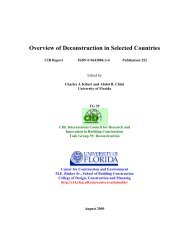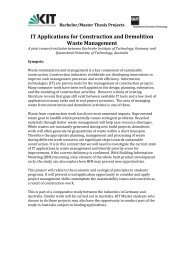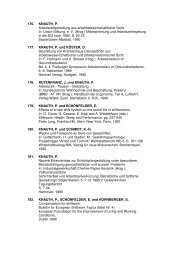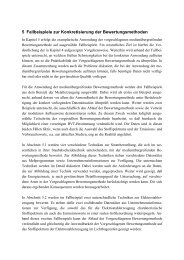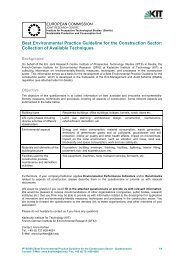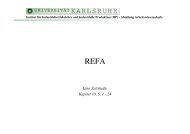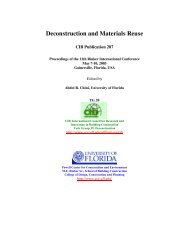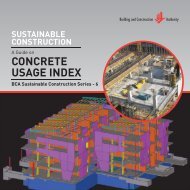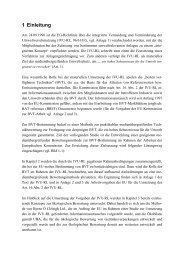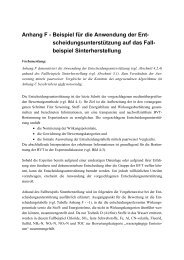Waste reduction final report -4 - Test Input
Waste reduction final report -4 - Test Input
Waste reduction final report -4 - Test Input
Create successful ePaper yourself
Turn your PDF publications into a flip-book with our unique Google optimized e-Paper software.
Discussion<br />
Contributed by:<br />
Gilli Hobbs<br />
Director of Resource Efficiency<br />
Building Research Establishment<br />
Watford, UK<br />
Looking through the country <strong>report</strong>s, there are common themes and issues that arise across<br />
the globe, mostly developed independently in each country. However, there are also many<br />
differences in terms of the level of importance placed upon reducing this wastestream and the<br />
priorities in each country depending upon the supply chain phase, material type and type of<br />
construction.<br />
<strong>Waste</strong> <strong>reduction</strong> tends to be a late arrival in policy and industry objectives related to<br />
Construction and Demolition <strong>Waste</strong> management and Sustainable building. A generic<br />
approach over time towards waste <strong>reduction</strong> could be as follows:<br />
• All waste is managed in such a way as to prevent pollution and harm to human health<br />
• Standards emerge relating to green or sustainable buildings, initially focussed on<br />
energy efficiency<br />
• Landfill is undesirable for recyclable materials leading to a focus on recycling and<br />
energy recovery of waste<br />
• Green building standards include wider measures such as recycling, recycled content<br />
• Improved evidence on waste amounts, composition and causes<br />
• <strong>Waste</strong> <strong>reduction</strong> is brought to the forefront of waste policy with related policy<br />
measures and business support focussed on waste <strong>reduction</strong><br />
• <strong>Waste</strong> <strong>reduction</strong> targets and methods of measurement are included in Green building<br />
standards<br />
• Supply chains and sectors work in partnership to identify and implement waste<br />
<strong>reduction</strong> actions<br />
• Ideally, waste production related to construction activity will start to decline –<br />
currently no country (that has <strong>report</strong>ed) seems to have reached this point.<br />
Policies that influence a focus on waste prevention include:<br />
1. Understanding the wastestream: Amount generated and characterisation of waste –<br />
who is responsible for collecting this information – regional or national, government<br />
or industry. If policy is not developed at a national/federal level than there is likely to<br />
be inconsistencies within the same country in terms of data provision, taxes and<br />
incentives to reduce waste, and other policies designed to discourage waste<br />
production and landfilling.<br />
2. Definition of waste and levels of management – the definition of waste can be a grey<br />
area across the world. Even where it has been set out in policy there are often<br />
different interpretations that can result. For example, the EU <strong>Waste</strong> Framework<br />
Directive definition of waste effectively counts any product or material that has been<br />
discarded by the holder to be a waste. As soon as the product or material is deemed<br />
waste then the legislation relating to environmental permitting and the transport of<br />
waste needs to be considered.<br />
3. Site waste management plans, waste <strong>reduction</strong> plans, and permits linked to these are<br />
commonplace around the world, for example in Canada. However, as noted in this<br />
149



